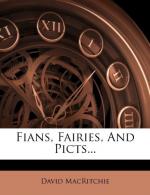This is the entry in his journal:—“See
frequently on the road-sides small verdant hillocks,
styled by the common people shi an (
sithean),
or the Fairy-haunt, because here, say they, the fairies,
who love not the glare of day, make their retreat
after the celebration of their nocturnal revels."[53]
Now, as the “Picts’ houses” are,
to outward appearance, “small verdant hillocks,”
the parallel is very exact. With these two references
compare also the mention, in a quaint old gazetteer
printed at Cambridge in 1693,[54] of the tribe of
the “Germara,” defined as “a people
of the Celtae, who in the day-time cannot see.”
Although the author usually gives the sources of his
information, in this instance he gives none.
But the statement agrees perfectly with the belief
found everywhere throughout Northern Europe that “the
dwarfs could not bear daylight, and during the day
hid in their holes."[55] It really seems impossible
to avoid the inference that all this was perfectly
true. When Leif went down into the underground
house in Ireland, he could not see at first, though
at length he saw in the obscurity the glimmer of his
opponent’s sword. Consequently, the denizens
and builders of these subterranean retreats must either
have had something very like “cat’s eyes,”
or else they must in general have had numerous lamps
burning. This will be understood by an examination
of one or two of the accompanying diagrams. It
seems to me beyond question that a people living this
underground life must have differed very distinctly
from ourselves in the matter of vision; and to them
the brightness of noonday must have been blinding.
This physical fact—if it be a fact—would
explain much that is otherwise strange and incredible
in the traditions relating to the Picts—or
Pechts, as they were formerly called in Scotland.
However, it is sufficient for my present purpose to
note that this peculiarity associates, and indeed
identifies, the Picts with the dwarfs or fairies of
tradition.
Having thus shown that Fians, Fairies, and Picts are
so closely associated as to be, in some aspects, almost
indistinguishable from one another, I shall now refer
to the structures which are popularly believed to
have been their dwellings. Some of these are wholly
underground, others partly so, and others quite above
ground. In many other ways, also, they vary.
But all of them are unquestionably links in one special
style of structure; of which the most marked feature,
or at any rate that which is common to all, is the
use of what is called the “cyclopean”
arch. This is formed by the overlapping of the
stones in the wall until they almost meet at the dome
or apex of the building, when a heavy “keystone”
completes this rude arch. The principle of the
arch proper was obviously quite unknown to the originators
of such structures.




